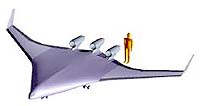| . |  |
. |
 NASA Selects New Aircraft Technologies For Research
NASA Selects New Aircraft Technologies For ResearchEdwards - May 9, 2000 - NASA's Office of Aero-Space Technology has selected nine aeronautical concepts for awards as part of its Revolutionary Concepts program, which accelerates the exploration of high-risk, revolutionary-breakthrough technologies in atmospheric flight. The selected projects will receive approximately $300,000 each for Phase I research. NASA's Dryden Flight Research Center, Edwards, Calif., is the lead center for the Revolutionary Concepts (REVCON) program, with significant involvement from NASA's Ames Research Center, Moffett Field, Calif.; Glenn Research Center, Cleveland, Ohio; and Langley Research Center, Hampton, Va. The nine winning projects are described below, Advanced Supersonic Propulsion and Integration Research aims to validate a two-dimensional, mixed-compression engine inlet for commercial applications. Glenn will lead this project with partners Dryden; Lockheed Martin Skunk Works, Palmdale, Calif.; United Technologies Research Center, East Hartford, Conn.; General Electric Aircraft Engines, Cincinnati, Ohio; Techland Research, North Olmsted, Ohio; Gulfstream Aerospace, Cleveland, Ohio; and the Air Force Research Laboratory, Dayton, Ohio. APEX is a highly instrumented, remotely piloted glider air-launched at an altitude of 100,000 feet by a balloon. It will obtain data to validate design and analysis methods for high altitude and high-subsonic speeds. Dryden leads a team that includes Ames, Langley and Glenn. Joined-Wing Integrated Structures Flight Demonstration is a revolutionary airborne surveillance concept consisting of a joined-wing aircraft with radar apertures integrated into the four joined wings. Langley is the lead with partners from Dryden; The Boeing Company, Phantom Works Division, Seattle, Wash.; Naval Air Systems Command, Patuxent River, Md.; and the Air Force Research Laboratory, Dayton, Ohio. The Reliable Autonomous Control Technology project will develop an autonomous management system for uninhabited aircraft to achieve reliability equivalent to current piloted aircraft. Dryden is the team lead, with partners Lockheed Martin Tactical Aircraft Systems, Fort Worth, Texas; Lockheed Martin Skunk Works, Palmdale, Calif.; and NASA's Jet Propulsion Laboratory, Pasadena, Calif. Revolutionary Propulsion for Aeronautical Vehicles is the combined effort of the lead General Electric Aircraft Engines, Cincinnati, Ohio, and partners General Electric Corporate Research and Development, Schenectady, N.Y.; Lockheed Martin Tactical Aircraft Systems; Advanced Projects Research, Inc., La Verne, Calif.; Air Force Research Laboratory, Dayton, Ohio; Glenn and Dryden. This team will design and develop a pulse-detonation technology to integrate with an existing engine and provide increased thrust and fuel efficiency. The Shape Memory Alloy Variable Area Fan Nozzle project will address the development of smart-material actuation for a variable-area fan nozzle. United Technologies Research Center will lead the project with support from partners, Pratt and Whitney, East Hartford, Conn.; Northrop-Grumman, Los Angeles, Calif.; Dryden, Glenn and Langley. Smart Vehicle -- Advanced Technology Demonstrator consists of an uninhabited technology demonstrator that will showcase innovative, hingeless aerodynamic effectors that will increase the maneuverability and performance of the vehicle with reduced signature. This project will be led by Langley with partners Lockheed Martin Tactical Aircraft Systems, Fort Worth, Texas; Physical Sciences, Inc., Andover, Maine; Tel Aviv University, Israel; Naval Air Systems Command, Patuxent River, Md.; and Dryden. Swashplateless Flight will be demonstrated by the team of Advanced Technologies, Inc., Newport News, Va.; Diversified Technologies, Inc., Bedford, Mass.; Ames, Dryden and Langley. They will integrate an on-the-blade, electromechanical servo-actuator into a civil helicopter and demonstrate primary flight control without using a mechanical swashplate. And finally, the goal of the Variable Diameter Tilt Rotor flight experiment is to advance the technology readiness of a concept that optimizes the rotor configuration for both hover and cruise flight. This project joins Sikorsky Aircraft Corporation, Stratford, Conn., as the lead with Dryden, Ames and Langley.
by Peter Hadfield Tokyo - April 14, 2000 - A revolutionary jet engine was unveiled at a Tokyo aerospace show last week. Designed to power a new generation of commercial aircraft that will fly at five times the speed of sound, the Hypersonic Transport Propulsion System (HYPR) is the brainchild of Japan's New Energy and Industrial Technology Development Organization (NEDO), a branch of the Ministry of International Trade and Industry.
|
| ||||||||||
| The content herein, unless otherwise known to be public domain, are Copyright 1995-2016 - Space Media Network. All websites are published in Australia and are solely subject to Australian law and governed by Fair Use principals for news reporting and research purposes. AFP, UPI and IANS news wire stories are copyright Agence France-Presse, United Press International and Indo-Asia News Service. ESA news reports are copyright European Space Agency. All NASA sourced material is public domain. Additional copyrights may apply in whole or part to other bona fide parties. Advertising does not imply endorsement, agreement or approval of any opinions, statements or information provided by Space Media Network on any Web page published or hosted by Space Media Network. Privacy Statement All images and articles appearing on Space Media Network have been edited or digitally altered in some way. Any requests to remove copyright material will be acted upon in a timely and appropriate manner. Any attempt to extort money from Space Media Network will be ignored and reported to Australian Law Enforcement Agencies as a potential case of financial fraud involving the use of a telephonic carriage device or postal service. |